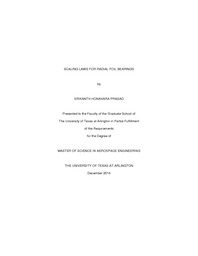
ATTENTION: The works hosted here are being migrated to a new repository that will consolidate resources, improve discoverability, and better show UTA's research impact on the global community. We will update authors as the migration progresses. Please see MavMatrix for more information.
Show simple item record
| dc.contributor.author | Honavara Prasad, Srikanth | en_US |
| dc.date.accessioned | 2015-07-01T17:50:35Z | |
| dc.date.available | 2015-07-01T17:50:35Z | |
| dc.date.issued | 2014-12 | |
| dc.date.submitted | January 2014 | en_US |
| dc.identifier.other | DISS-12963 | en_US |
| dc.identifier.uri | http://hdl.handle.net/10106/24968 | |
| dc.description.abstract | The effects of fluid pressurization, structural deformation of the compliant members and heat generation in foil bearings make the design and analysis of foil bearings very complicated. The complex fluid-structural-thermal interactions in foil bearings also make modeling efforts challenging because these phenomena are governed by highly non-linear partial differential equations. Consequently, comparison of various bearing designs require detailed calculation of the flow fields (velocities, pressures), bump deflections (structural compliance) and heat transfer phenomena (viscous dissipation in the fluid, frictional heating, temperature profile etc.,) resulting in extensive computational effort(time/hardware). To obviate rigorous computations and aid in feasibility assessments of foil bearings of various sizes, NASA developed the "rule of thumb" design guidelines for estimation of journal bearing load capacity. The guidelines are based on extensive experimental data.The goal of the current work is the development of scaling laws for radial foil bearings to establish an analytical "rule of thumb" for bearing clearance and bump stiffness. The use of scale invariant Reynolds equation and experimentally observed NASA "rule of thumb" yield scale factors which can be deduced from first principles. Power-law relationships between: a. Bearing clearance and bearing radius, and b. bump stiffness and bearing radius, are obtained. The clearance and bump stiffness values obtained from scaling laws are used as inputs for Orbit simulation to study various cases.As the clearance of the bearing reaches the dimensions of the material surface roughness, asperity contact breaks the fluid film which results in wear. Similarly, as the rotor diameter increases (requiring larger bearing diameters), the load capacity of the fluid film should increase to prevent dry rubbing. This imposes limits on the size of the rotor diameter and consequently bearing diameter. Therefore, this thesis aims to provide the upper and lower bounds for the developed scale laws in terms of the bearing diameter. | en_US |
| dc.description.sponsorship | Kim, Daejong | en_US |
| dc.language.iso | en | en_US |
| dc.publisher | Aerospace Engineering | en_US |
| dc.title | Scaling Laws For Radial Foil Bearings | en_US |
| dc.type | M.S. | en_US |
| dc.contributor.committeeChair | Kim, Daejong | en_US |
| dc.degree.department | Aerospace Engineering | en_US |
| dc.degree.discipline | Aerospace Engineering | en_US |
| dc.degree.grantor | University of Texas at Arlington | en_US |
| dc.degree.level | masters | en_US |
| dc.degree.name | M.S. | en_US |
Files in this item
- Name:
- HonavaraPrasad_uta_2502M_12963.pdf
- Size:
- 907.9Kb
- Format:
- PDF
This item appears in the following Collection(s)
Show simple item record


